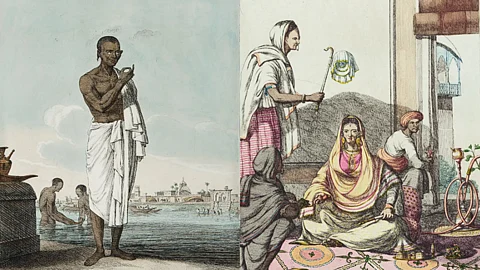
- HOMEGROWN WORLD
- #HGCREATORS
- #HGEXPLORE
- #HGVOICES
- #HGSHOP
- CAREERS
- ABOUT US
- CONTACT US

In the bustling heart of 18th-century Calcutta, a Belgian artist named Baltazard Solvyns embarked on an ambitious project. Far from his native Antwerp, Solvyns wasn't just captivated by the city's vibrant energy – he sought to capture its very essence, its cultural tapestry woven from daily life, traditions, and the people themselves. The result? A remarkable collection of etchings that retroactively proves to be an unparalleled visual record of Bengal during the 1790s.
Solvyns wasn't your typical colonial artist. Born in 1760, he arrived in Calcutta in 1791, driven by political unrest in Europe rather than the patronage of the East India Company. This outsider status, in a way, fueled his artistic vision. Unconstrained by the conventions of European portraiture, Solvyns immersed himself in the kaleidoscope of Bengali life. He took on varied artistic endeavors – painting for theaters, sketching for the Surveyor-General – all the while honing his keen eye for detail.
Encouraged by the burgeoning interest in Orientalism and the support of figures like Sir William Jones, Solvyns set out to create a comprehensive ethnographic survey. His etchings, meticulously crafted and numbering over 250, became the first of their kind. Unlike the idealized landscapes or romanticized portraits favored by some European artists, Solvyns' work pulsates with earnest authenticity.
In his etchings you'll find yourself amidst bustling bazaars, their stalls overflowing with exotic wares. Solvyns had a meticulous eye for the sartorial choices of the time — the intricate folds of dhotis and the colorful turbans adorning heads, each line etching a story of the wearer's profession or social standing. Along with the people of Bengal, Solvyns also nuanced captures its rich cultural practices — the grandeur of Durga Puja captured in a tableau, the idol readied for immersion and devotees chanting in fervent celebration is a prime example.
Solvyns’ etchings are more than just a catalog of customs and attire. They brim with life. We see the rhythmic strokes of the oarsmen navigating the mighty Hooghly river on a variety of boats – from houseboats to trading vessels, each meticulously rendered. The Nariel Houka (Hookah) etching captures the leisure of a smoking session, while the D'houlok (Dhol) depicts a musician, his posture conveying the power and passion of his craft.
Solvyns' artistic style is as captivating as his subject matter. His etchings, with their sharp lines and nuanced shading, bring depth and texture to the scenes. The recurring motif of white clothing, perhaps a reflection of Bengal's tropical climate, adds a sense of serenity amidst the bustling energy.
The significance of Solvyns’ etchings extends far beyond its visual merit. It's a historical document of unparalleled value. Solvyns, the perceptive outsider, offers a window into a bygone era, capturing the social hierarchy, the prevalent occupations, and the very essence of Bengali life in the 1790s. His work serves as a cornerstone for understanding Bengal's cultural heritage at the time. What's most interesting to me is the fact that even though he is Belgian, his etchings are considered the prototype for the Company Paintings, a school of paintings where Indian artists documented their own culture for British patrons.
Solvyns’ remarkable work is a record of a time and place etched not just on paper, but in the collective memory of Bengal. Thanks to the efforts of the Delhi Art Museum (DAG), they have been preserved well, and now, you can view these rare works of art at an upcoming exhibition titled People Of Bengal: Colored Etchings By F. Baltazard Solvyns at the Bhau Daji Lad Museum in Mumbai. Curated by Giles Tillotson, this exhibition opens on 27 April 2024 and is on view till 29th June 2024.
